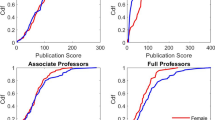Abstract
Although the statistics on science and engineering personnel inScience Indicators — 1976 can be used to trace changes in the supply and utilization of these personnel, very little is presented that would allow readers to discern the emergence of strengths or weaknesses in this area. The author suggests that the inclusion of a variety of indicators relating to age, quality and mobility of scientific personnel would be a useful addition to the chapter. Additional indicators of labor market change, such as salaries, would also be helpful for policy purposes.
Similar content being viewed by others
Explore related subjects
Discover the latest articles and news from researchers in related subjects, suggested using machine learning.References
K. ARROW, W. CAPRON, Dynamic Shortage and Price Rises: the Scientist-Engineer the Engineer-Scientist Case,Quarterly Journal of Economics, 73 (May 1959) 292–308).
D. BLANK, G. STIGLER,The Demand and Supply of Scientific Personnel, National Bureau of Economic Research, Washington, D. C. 1957.
J. COLE, S. COLE,Social Stratification in Science, University of Chicago Press, Chicago, 1973.
R. B. FREEMAN,The Market for College-Trained Manpower, Harvard University Press, Cambridge, MA 1972.
R. MERTON,Sociology of Science, University of Chicago Press, Chicago, 1973.
National Academy of Sciences Commission on Human Resources,Doctoral Scientists and Engineers in the United States, 1973 Profile, National Academy of Sciences, Washington, D. C. 1974.
National Academy of Sciences Commission on Human Resources,Doctoral Scientists and Engineers in the United States, 1975 Profile, National Academy of Sciences, Washington, D. C. 1976.
National Academy of Sciences Commission on Human Resources,Doctorate Recipients from United States Universities, Summary Report, annual volumes, National Academy of Sciences Washington, D. C.
B. L. R. SMITH, J. J. KARLESKY,The State of American Science, Change Magazine Press, New York, 1977.
Author information
Authors and Affiliations
Additional information
The work on markets for mathematics reported here is being conducted as part of a project sponsored by the Conference Board on Mathematical Sciences supported by the National Science Foundation. The work on mobility in academic labor markets is sponsored by the Carnegie Council on Policy Studies in Higher Education and supported by the Ford Foundation.
Rights and permissions
About this article
Cite this article
Kuh, C.V. Indicators of scientific manpower. Scientometrics 2, 395–403 (1980). https://doi.org/10.1007/BF02095082
Received:
Issue Date:
DOI: https://doi.org/10.1007/BF02095082




